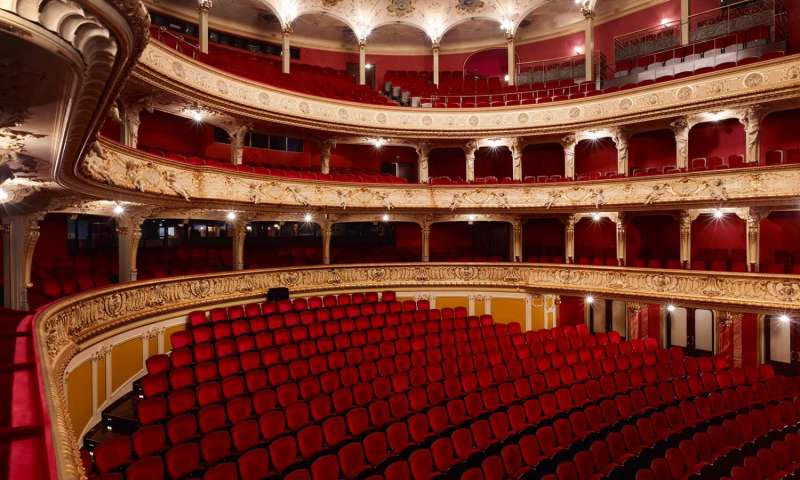April 29, 2016

With SpatialSound Wave, sounds are easily positioned in the space via the tablet. In the Zurich Opera House, the sound engineers use the software to record sound effects and spatial acoustics live. Credit: © Photo Fraunhofer IDMT
With the audio software SpatialSound Wave from Fraunhofer, sounds can be positioned freely in the room, so that visual and acoustic events coincide realistically. In the Zurich Opera House the three-dimensional sound has been in use since January. The sound technicians adjust sound effects live and enlarge spaces acoustically.
Modern opera productions depend on the singing technique of the main characters, the extravagant stage design or the musicians in the orchestra. At the same time, the directors achieve additional soundscapes with sound effects from the speaker. "Especially in modern productions, directors require us to produce various sound effects, create different spaces and connect with each other over the sound system," says Oleg Surgutschow, sound mixer at the Zurich Opera.
In the historic hall, loudspeakers are mounted on a total of five levels. "A large and complex infrastructure that has grown historically. With classic speaker technology limits are quickly reached when wanting to achieve spacial audio effects," says René Rodigast of the Fraunhofer Institute for Digital Media Technology IDMT. The SpatialSound Wave technology of the Ilmenau researchers in Zurich has been in use since early 2016. The advantage for the sound mixer Surgutschow is that he can edit sound effects live and create spatial, three-dimensional soundscapes – without having to change the sound system or the space for it.
The SpatialSound Wave software distributes the sounds according to the process of wave field synthesis. As a result, various speakers form a new acoustic waveform. None of the speakers plays the same signal. Each speaker complements the neighboring one and contributes its share to the overall sound. "We only have to tell the technology in advance where each speaker is", Rodigast explains. "With microphones, we measure the sound of each individual loudspeaker".

The Zurich Opera dates back to 1891. It was originally conceived as a legitimate theater and has several levels. Credit: © Photo Zurich Opera
Position the sound, not the loudspeaker
SpatialSound Wave makes the acoustic signals of the speakers into audio objects. A sound thereby receives a three-dimensional XYZ-axis and an exact position for a certain time. Sounds in a room can thereby be positioned wherever they are wanted. The calculated signal flows back into the speaker system of the opera house. "It's no longer tied to the position of the speaker", says Rodigast. Sound mixer Surgutschow no longer has to worry about his speakers; he only has to position the sounds. The volume and the natural delay of the sounds of each speaker, which are responsible for a particular sound, are automatically calculated by means of mathematical formulas. Since multiple speakers act together, they can adjust the position of the sound source. As a result, each audio signal has a fixed position in space. "The result is a stable acoustic event which is perceived in the same way from every seat in the opera house", Rodigast explains.
Originally, the Zurich Opera House was designed as a playhouse, a theater of the spoken word. It therefore makes for excellent speech intelligibility, but the reverberation time is too short for opera performances. This can be extended with SpatialSound Wave. Instead of audio, the researchers send reflections to certain points of the space. "We add another signal to the original sound source and can affect the time and length of the reflections," says Rodigast. This makes the room larger. As if the walls are being moved to the back.
"With the software, we can spontaneously adjust effects and surround sound in live operation. We used to have to preprogram all the effects. The audio objects can be positioned such that they can appear to be at different distances for the listener. That means I can place the effects so that it seems, that they are outside the room" says Surgutschow.
Fine tuning with the ears
The seating of the Zurich Opera House is classically arranged: stalls, stalls gallery, circle 1, circle 2 including boxes, upper circle and balcony. "The different levels at different heights make it very challenging to adjust the acoustics perfectly: for example, to provide the same sound experience or soundscapes that move through the space at each location", says Surgutschow. "In such a case, microphones are not enough to measure the volume. That is only for the technical approach. More important is the pre-faded listening with one's own ears". Scientists and engineers went from seat to seat and from box to box, played different sound contents, moved sound sources to different locations. "You experiment with different settings. No technology can do away with that," says Rodigast. There were two dates: on one day, the system was measured and put into operation. "We optimized it acoustically in two nights, after the sound engineers had previously worked for a few weeks with the technology", says Rodigast.
Provided by: Fraunhofer-Gesellschaft
Read more at: http://phys.org/news/2016-04-3d-zurich-opera-house.html#jCp